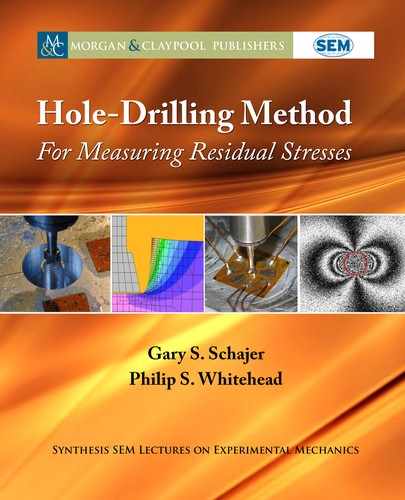6.4. INSTALLATION ON IRREGULAR SURFACES: BOND THICKNESS 129
is type of orientation has been used for all Type B rosette installations shown in the
previous sections in this chapter. It may be the case that, at some features, the directions of
principal strains and stresses are not known prior to the test (for example, from additional shear
loading along a weld line). In these cases, a preliminary gauge can be installed and drilled to
establish the directions of principal stresses prior to installing rosette(s) at some distance from
the preliminary gauge.
6.4 INSTALLATION ON IRREGULAR SURFACES: BOND
THICKNESS
Chapter 4 discusses specimen surface preparation for gauge installation. For measurements on
irregular surfaces where it is deemed unacceptable to apply any smoothing, additional measures
must be taken to ensure that the bond between the rosette and specimen is as thin as possible.
To achieve such a bond, the most flexible gauge construction must be selected, for example an
open 1/32” or 1/16”-size rosette. Figure 6.8a shows such a rosette installed on an unsmoothed
cast surface, illuminated by a uniform, low-level light source. It may not be possible to deter-
mine whether a suitable bond has been achieved by visual inspection under these conditions.
Figure 6.8b shows a rosette installed on a shot-peened surface, illuminated by a bright spot-
light source to create clear reflections of the light on the rosette surface. By inspection of the
surface in this way, it is possible to form a judgement as to whether the gauge backing material
follows the surface of the specimen. Viewing under the conditions in Figure 6.8b is also useful
for determining whether any areas of the adhesive have cured prematurely, prior to application
of the bond pressure.
Figure 6.8c provides another example of viewing the gauge with spot-light illumination.
In this case, the specimen surface is a machined (turned) surface with very much smaller irreg-
ularities than the shot-peened surface in the previous example. e “witness” of the machining
marks can be clearly seen in the reflected light. By applying high pressure during bonding, it is
possible to achieve very thin bond lines such that quite fine surface markings become visible at
the open gauge rosette surface.
A more quantitative approach to bond thickness assessment can be achieved using the
arrangement shown in Figure 6.8d. In this example, a section through an open gauge, the rosette
surface is illuminated by a point light source at an angle of 45
ı
. e user then views the gauge
in a direction perpendicular to the target surface using the drilling machine optical head. Any
offset in the plane of the surface between the outline of the metallic gauge film and its shadow
when viewed on the target surface through the transparent backing material and adhesive equals
the height of the gauge film above the surface. e offset can be measured using the optical head
graticule scale. Subtraction of the backing material thickness from the shadow offset provides
an indication of the bond thickness. is thickness is typically around 20–30 m. e same
method can be used to determine any variability in bond thickness under encapsulated gauges,
where inspection of the encapsulation surface is less revealing than for open gauges.
..................Content has been hidden....................
You can't read the all page of ebook, please click here login for view all page.
